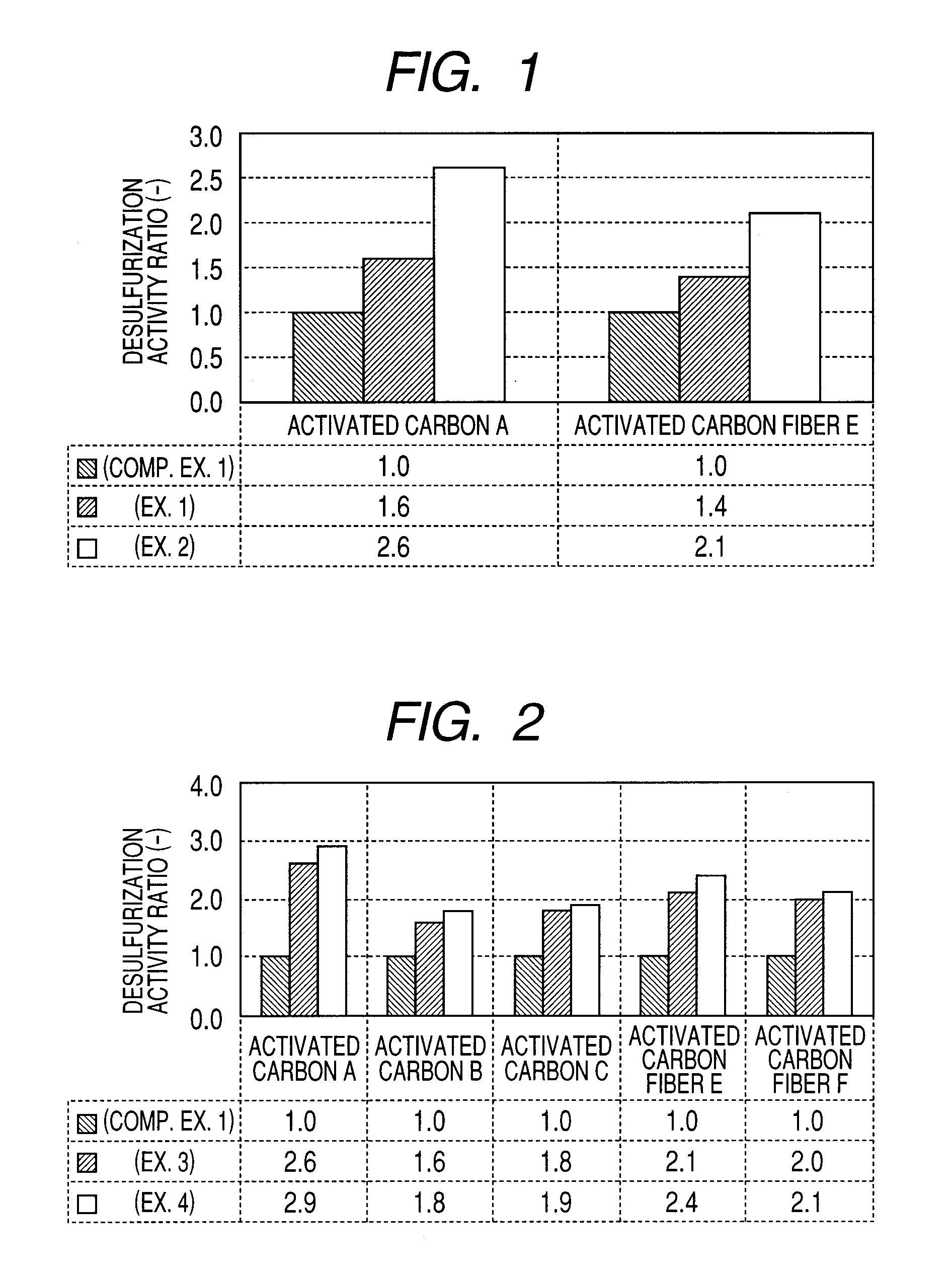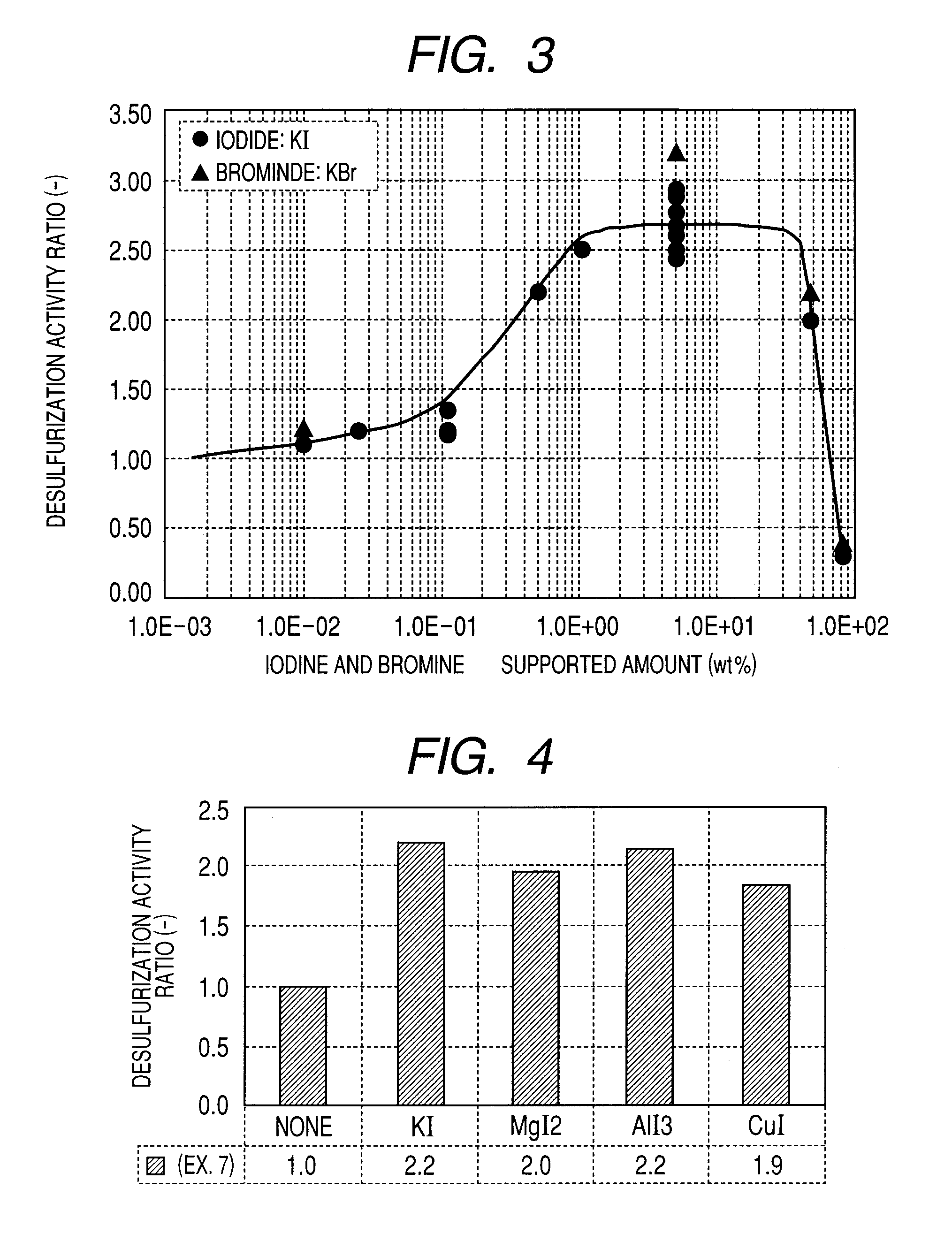Carbon-based catalyst for flue gas desulfurization and method of producing the same and use thereof for removing mercury in flue gas
a technology of desulfurization and carbon-based catalysts, which is applied in the direction of physical/chemical process catalysts, emission prevention, separation processes, etc., can solve the problems of low catalyst activity in catalytic desulfurization, inability to efficiently exhaust generated sulfuric acid, and inability to maintain stably the activity of catalysts, so as to reduce the amount of catalyst needed and stable desulfurization performance
- Summary
- Abstract
- Description
- Claims
- Application Information
AI Technical Summary
Benefits of technology
Problems solved by technology
Method used
Image
Examples
first example
Example 1
[0093]As a carbon-based catalyst for flue gas desulfurization involving Example 1, carbon-based catalysts for flue gas desulfurization involving the present invention were produced in such a manner that the activated carbon A and activated carbon fiber E were used to support KI that is an iodide and water repellent treated.
[0094]Firstly, activated carbon A pulverized to an average particle diameter of 20 to 200 μm and activated carbon fiber E cut to 3 mm or less were impregnated under reduced pressure with an aqueous solution of KI to support. At this time, a supported amount of KI was dissolved to prepare a supporting amount. In the next place, to 90 parts by weight of KI-supported activated carbon C and activated carbon fiber E, an aqueous dispersion of polytetrafluoroethylene (manufactured by Daikin Industries Ltd., resinous solid content: 60% by weight) was mixed so as to be 10 parts by weight by solid concentration, followed by kneading with a pressure kneader, further...
example 2
[0097]As a carbon-based catalyst for flue gas desulfurization involving Example 2, carbon-based catalysts for flue gas desulfurization involving the present invention were produced in such a manner that with the activated carbon A and activated carbon fiber E, the inside of pores thereof were previously impregnated with water, followed by supporting KI that is an iodide and by water repellent treating.
[0098]Firstly, activated carbon A pulverized to an average particle diameter of 20 to 200 μm and activated carbon fiber E cut to 3 mm or less were impregnated with water according to the impregnation under reduced pressure. Then, the activated carbon was impregnated under reduced pressure with an aqueous solution of KI to support. At this time, a supporting amount of KI was dissolved to prepare a supported amount. In the next place, to 90 parts by weight of KI-supported activated carbon A and activated carbon fiber E, an aqueous dispersion of polytetrafluoroethylene (manufactured by Da...
second example
[0101]In order to verify whether an improvement effect in desulfurization performance is different or not between a case where iodine or a compound thereof is supported by the activated carbon or the like and a case where bromine or a compound thereof is supported, activated carbon catalysts for flue gas desulfurization of following Example 3 and Example 4 were used to verify.
PUM
| Property | Measurement | Unit |
|---|---|---|
| Percent by mass | aaaaa | aaaaa |
| Percent by mass | aaaaa | aaaaa |
| Percent by mass | aaaaa | aaaaa |
Abstract
Description
Claims
Application Information
 Login to View More
Login to View More - R&D
- Intellectual Property
- Life Sciences
- Materials
- Tech Scout
- Unparalleled Data Quality
- Higher Quality Content
- 60% Fewer Hallucinations
Browse by: Latest US Patents, China's latest patents, Technical Efficacy Thesaurus, Application Domain, Technology Topic, Popular Technical Reports.
© 2025 PatSnap. All rights reserved.Legal|Privacy policy|Modern Slavery Act Transparency Statement|Sitemap|About US| Contact US: help@patsnap.com



